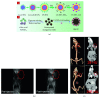Nanoparticle-Based Paramagnetic Contrast Agents for Magnetic Resonance Imaging
- PMID: 31191182
- PMCID: PMC6525923
- DOI: 10.1155/2019/1845637
Nanoparticle-Based Paramagnetic Contrast Agents for Magnetic Resonance Imaging
Abstract
Magnetic resonance imaging (MRI) is a noninvasive medical imaging modality that is routinely used in clinics, providing anatomical information with micron resolution, soft tissue contrast, and deep penetration. Exogenous contrast agents increase image contrast by shortening longitudinal (T 1) and transversal (T 2) relaxation times. Most of the T 1 agents used in clinical MRI are based on paramagnetic lanthanide complexes (largely Gd-based). In moving to translatable formats of reduced toxicity, greater chemical stability, longer circulation times, higher contrast, more controlled functionalisation and additional imaging modalities, considerable effort has been applied to the development of nanoparticles bearing paramagnetic ions. This review summarises the most relevant examples in the synthesis and biomedical applications of paramagnetic nanoparticles as contrast agents for MRI and multimodal imaging. It includes the most recent developments in the field of production of agents with high relaxivities, which are key for effective contrast enhancement, exemplified through clinically relevant examples.
Figures





References
-
- Bao Y., Sherwood J. A., Sun Z. Magnetic iron oxide nanoparticles as T1 contrast agents for magnetic resonance imaging. Journal of Materials Chemistry C. 2018;6(6):1280–1290. doi: 10.1039/c7tc05854c. - DOI
Publication types
MeSH terms
Substances
LinkOut - more resources
Full Text Sources
Other Literature Sources
Medical
